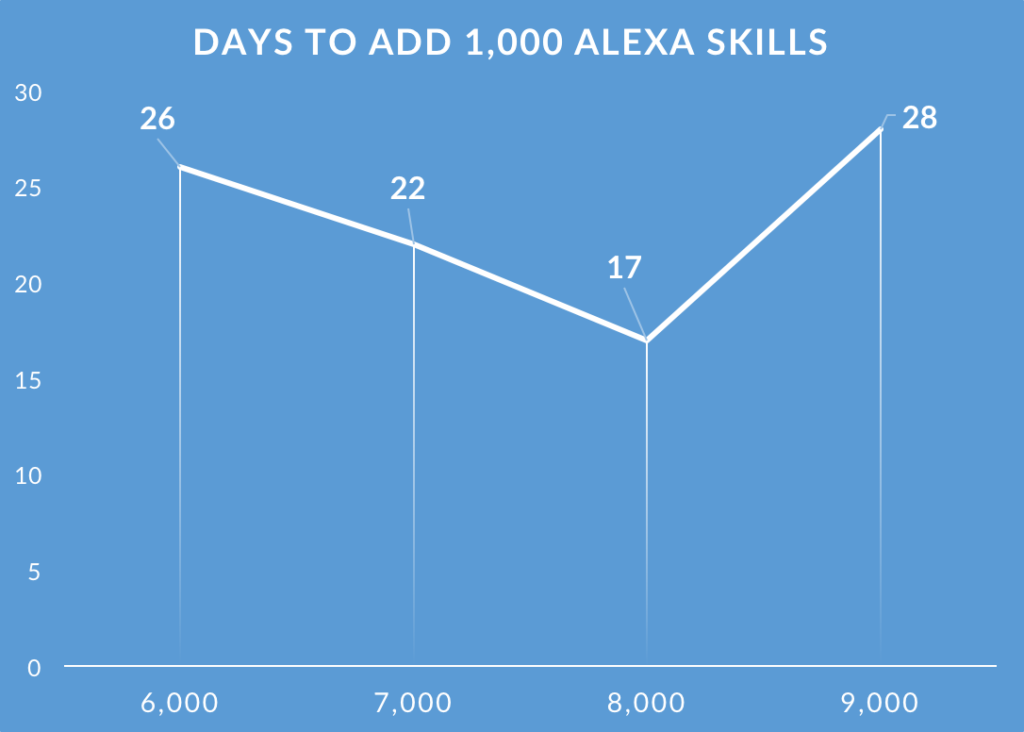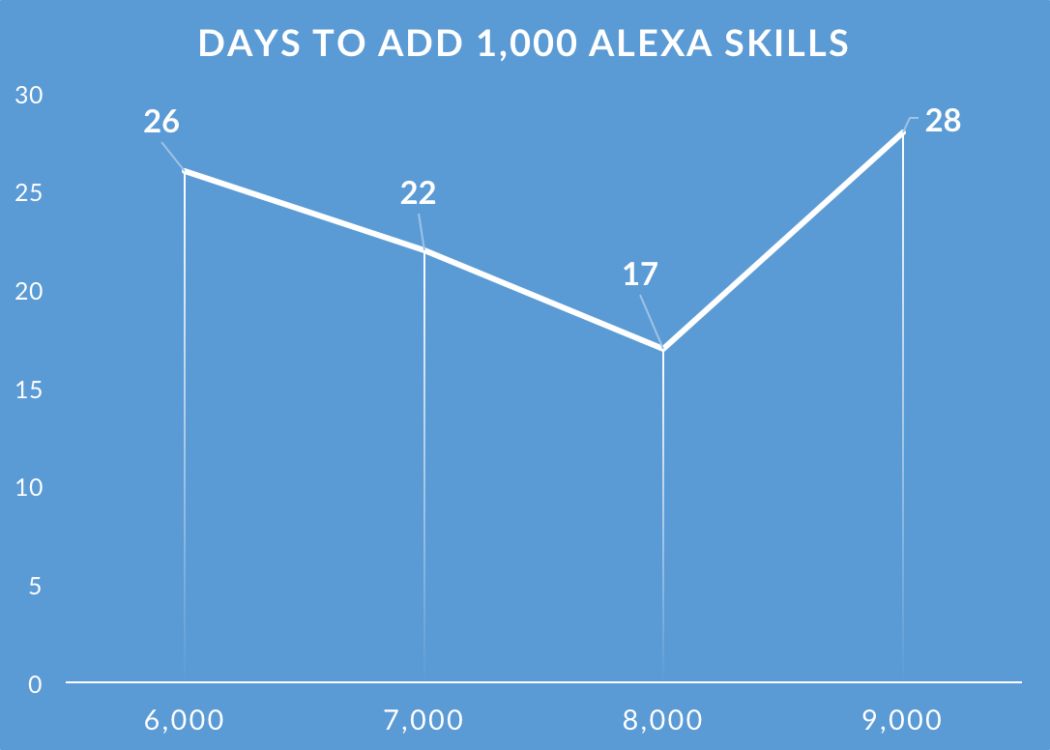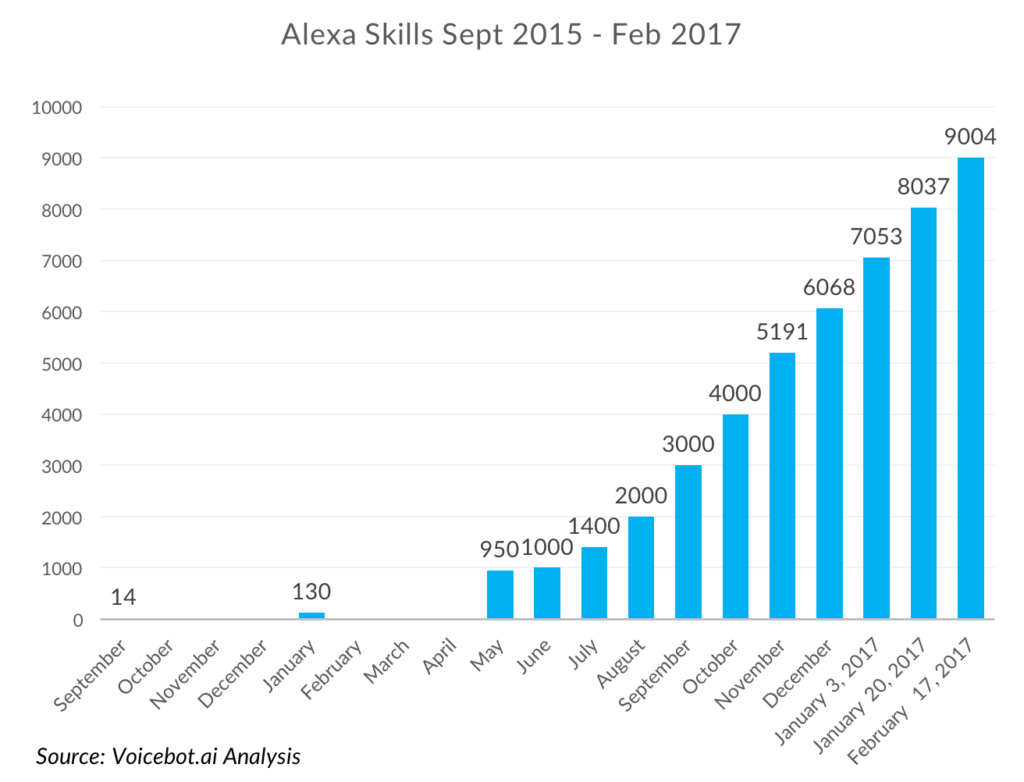Amazon Alexa Skills Pass 9000, Rate Slows
Although an Amazon representative said there were 9,000 Alexa skills at a meeting Thursday evening, the real tally that day was 8,946 and the next morning it jumped to 8,954. We can forgive rounding that reflects only about 0.06%. However, Amazon did enter the weekend with 9,004 Alexa skills so we now have passed the latest milestone and 10,000 isn’t far away.
From 17 Days to 28 Days for 1,000 New Skills
The more interesting trend is the time it has taken to add the latest 1,000 skills. The time it took to go from 5,000 – 6,000 Alexa skills was approximately 26 days. The time to go from 6,000 – 7,000 was 22 days and it was only 17 days from 7,000 – 8,000. That is a nice curve which suggests Alexa skill supply was growing at an increasing rate. However, that was followed by the rise to 9,000 taking 28 days. That is the slowest rate since November.

A number of factors could contribute to this. For example, there could be:
- Fewer Alexa skills being submitted during the period
- A rise in the percentage of skills being rejected and sent back to developers for revision
- A bottleneck in the Alexa review team with many skills close to approval that will come about shortly
- Developers turning their focus on localizing their existing skills for Amazon UK and German users
- Developers turning their attention to porting existing Alexa skills to Google Actions
Unpacking Potential Scenarios Behind the Slowdown
There could be other many reasons, but let’s first consider each of those listed above. If there are fewer Alexa skills being submitted it may be that January is a slow month for productivity in general as people are distracted by preparing for the year and kicking off new projects. Similarly, the rapid rise for end of December and early January submissions could have been driven by a year-end push by developers to complete their projects in 2016 with the approval process slated for early 2017. This factor in particular could account for the rapid rise of new skills approved in early January. Another possibility is that many of the developers that wanted to build for Alexa have run through their early ideas and the rate has naturally slowed before another wave of ideas and developers come along.
The next two factors are operational. Amazon could be enforcing standards more diligently in hopes of approving higher quality skills which means a higher percentage of initial submissions would be rejected. Similarly, newer Alexa developers amy be submitting skills and reducing the acceptance rate due to inexperience. Neither of these are likely to reduce the overall number of new skills in the system assuming that revisions will be made and the skills resubmitted and approved. Another operational issue could simply be a bottleneck for approving skills. Amazon is reviewing every skill before approving them to go live. If there are many in queue and some are more complex, it could have created a temporary bottleneck. Again, this wouldn’t change the total number of skills, but would simply push their availability out later.
Amazon could also be inadvertently causing a slowdown as it encourages skill developers to localize their skills for the UK and German markets. Two weeks ago, Amazon released its Alexa Voice Service (AVS) update for British English and German. If developers begin focusing their time on localization it will likely displace time that could be applied to new skill development.
Finally, there is another market factor to consider. Actions on Google for developers was announced on December 8th. That is the Google developer equivalent to Alexa Skills Kit (ASK). It was also the first time that most Alexa skill developers had the opportunity to start building for Google Home and Google Assistant. You could imagine developers finishing up their Alexa skills in December and then shifting their efforts to replicate those skills as Google Actions. That time would also displace efforts directed toward new Alexa skill development.
What Does This Mean for the Alexa Ecosystem
When PC sales started to grow, a key differentiation in the value of the different operating systems (OS) was how many applications could run on them. A larger number of applications supported on an OS was viewed as a benefit to consumers because they had more choice and there was a higher likelihood that something they wanted would be available. This same process played out in mobile. As Android was building its user base, there were always the claims that it was less useful than Apple’s iPhones, because there was such disparity in the number of apps available to consumers. Apple had many, many more initially. Android later caught up in the number of apps and then went on to take much larger smartphone market share than Apple.
We can see the same scenario playing out in voice applications. Like Apple in smartphones, Amazon’s Alexa had a big head start in voice applications. The fact that it has so many skills means that there is a lot of utility for consumers on day one. The thinking goes that there is something for everyone. It is interesting that Google finds itself in a familiar position. The total number of Actions on Google range from 1-2% of the total number of Alexa skills. That is quite a disparity. But Google has used the come from behind strategy before and will be working hard to close the gap. The gap will be easier to close if the release of Alexa skills slows.
That is one reason why the slowdown is worth noting. It may turn out to be a minor event and taking growth into context over a quarter or year may overwhelm the short-term numbers. Amazon certainly has sold a lot of Echo devices and is being embedded in dozens of third-party devices. And, new Alexa skills in January were well over 1,000 while Google announced 10. There is clear interest from both the demand and supply sides of the equation for the Alexa ecosystem. Tell us what you think about the reason for the slow down and whether it matters by joining The Voice Web LinkedIn Group.
Follow @bretkinsella










